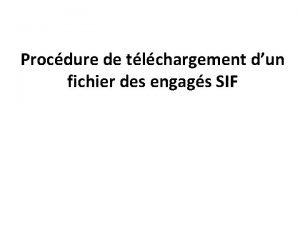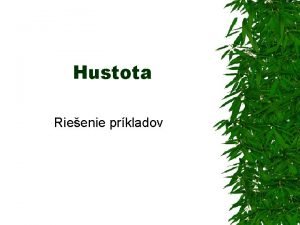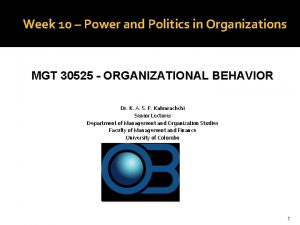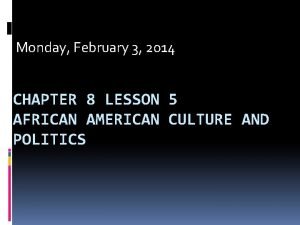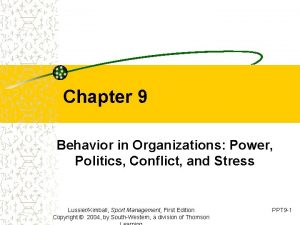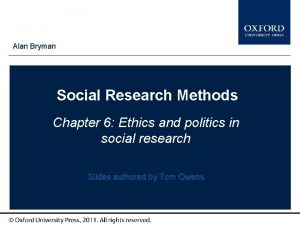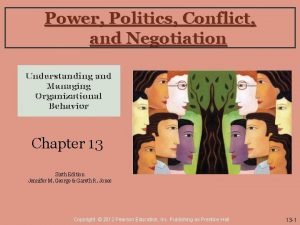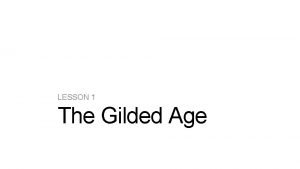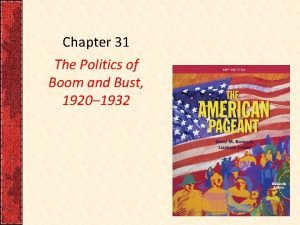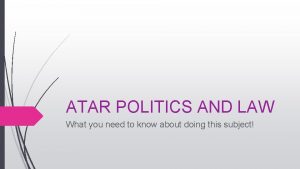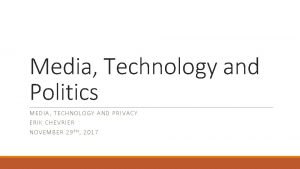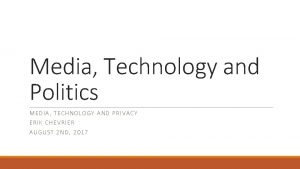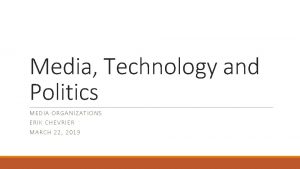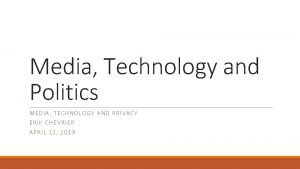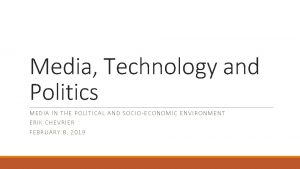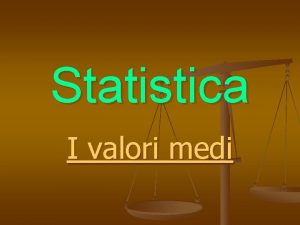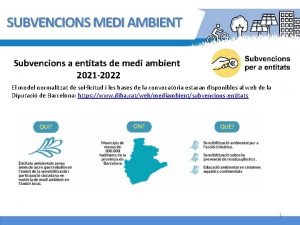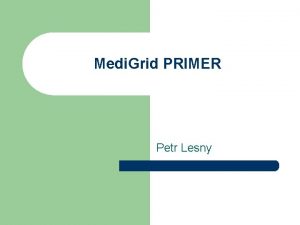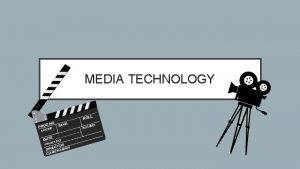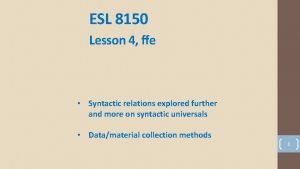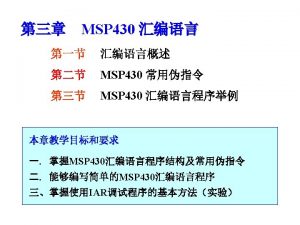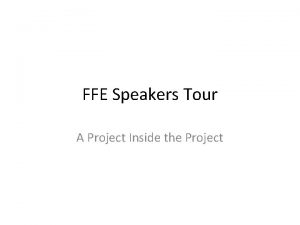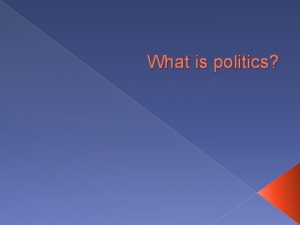Media Technology and Politics MEDI A E FFE


























- Slides: 26

Media, Technology and Politics MEDI A E FFE CTS ERIK C HEVRIER APRI L 5 T H , 2019

Media Effects Media effects research usually describes the reception/reading of codes/forms/texts Receivers are also affected by (and have an effect on) ◦ Media organizations and technology ◦ Political and socio-economic environment Media Organizations and technologies are affected by (and have an effect on) ◦ Political and socio-economic environment ◦ Receivers (audiences) Mc. Luhan – The Medium is the message Machines are an extension of our human experience and bodily sensations

How are you Affected by Media General Examples Very basic examples of how I can affect your emotional state via video ◦ Example 1 ◦ Example 2 ◦ Example 3 Small variations in media texts produce different interpretations ◦ Example People are fallible ◦ Example What do people learn from media? ◦ Example

Me-Media Problems with studying media effects ◦ Media changes rapidly and suddenly ◦ Scholars are continuously trying to keep up with the rapidly changing media landscape ◦ Turns scholars into ‘storm chasers’

Media Effects – Me-Media Democracy vs illusion of involvement Democracy ◦ Todd Gitlin (1999) – “Because of technology, relentless horizontal momentum is irreversible. The vertical cannot hold…Roll over authorities – the culture of the next millennium is not going your way. ” ◦ Francis Fukuyama – “hierarchies of all sorts, political and corporate, have come under pressure and begun to crumble” ◦ Esther Dyson – “the great virtue of the Internet is that it erodes power. It sucks power out of the center and takes it to the periphery: it erodes the power of institutions over people while giving to the individuals the power to run their own lives”. ◦ Manuel Castells – “ ‘network’ society had become so expansive, powerful, global, and instant that it had the capacity to overwhelm and sideline the nation state” ◦ Manuel Castells – Later admits that media conglomerates dominate many areas of these networks and nation states have a stubborn staying power, levers of control over the organization of daily life, and an emotional bond with their citizens that make them difficult to circumvent.

Media Effects - Me-Media Democracy vs illusion of involvement Illusion of involvement Malcolm Gladwell – Social media “are effective at increasing participation – but lessening the level of motivation that participation requires”. “Little can be achieved without strong leaders, hard core political action and specific policy solutions”. Manuel Castells – It is the looseness and diversity of these movements that allow these movements to create their own cyberenvironment, a signature of their success. Clay Shirky – The very virtues that can make online political engagement so effective – such as the ability to reach millions and stretch across the globe – can also be impediments to action. ◦ Cognitive surplus Christopher Waddell on the 2011 Canadian Election – Social media did NOT figure predominantly into the Canadian election campaign or it’s outcome because: Limited number of people on social media, narrow range of issues highlighted, lack of impact on issues, not many uses for social media. 2012 USA presidential elections had 9% less voter turnout than the previous election VOTE TOGETHER CAMPAIGN

Media Effects - Me-Media Efficiency vs inefficiency Efficiency ◦ Digital natives learn to multi-task, orient to networks and monitor their environments in ways that the pre-digital world is unable to match Inefficiency ◦ ◦ People are less able to think deeply about a problem We are being rewired into shallow thinkers We do not fully engage with the communities we get involved with online Digital ADD

Media Effects - Me-Media Identity ◦ ◦ ◦ ◦ ◦ Identity ghettos Self-confirming bias (confirmation bias) Selective exposure Search bias (algorithm based on previous searches) Echo chamber Greater number of choices leads to political polarization Self-performance and management of impressions Social capital ‘online friends’ Feelings of missing out Sunstein – narrowing information happens in two ways: ◦ Loss of by-product learning ◦ Information ghettos expose people to limited information pool Markus Proir – People who are interested in politics tend to migrate from news program to news program regardless whether they are liberal or conservative.

Media Effects - Me-Media Absence in presence – attention is elsewhere Presence in absence – you can be there even if you are not physically present (telepresence) ◦ Erosion of time and space Inequalities persist – Access problem, subscriptions, etc. Dangers – Privacy, data, cyber-bullying, extreme content

Media Effects – Cable Explosion Narrowcasting and fragmentation Subscriptions (advertising and subscription costs) Audience niche Cable revolution weakened structures of Canadian television: ◦ ◦ ◦ Syphoning away money from advertisers Competition, reluctance to invest in high-quality productions Altered boundaries towards more sensational programming Offloading of politics to the back alleys of TV Canadian content cannot compete

Media Effects – Blogs Journalism vs blogging ◦ ◦ ◦ Blogging not seen as a credible form of journalism Bloggers may be able to respond to a story more quickly Some journalists get information from blogs to begin a story Blogging may provide missing perspectives not covered by mainstream media Blogging is like journalism without a salary and organization to back you up with legal troubles Four categories of blogs ◦ ◦ Cyber-Celebrities Aggregator - centralizes a number of news and blog sites Celebrities themselves Ordinary people

Media Effects - You. Tube Largest online video archive Greatest teaching tools Attracting more and more advertising National television are a large part of You. Tube content News moments Amateur production Mobilizing citizens – contagion effect ◦ Double edge sword – spying on activists

Media Fantasy Becomes Reality Jean Baudrillard ◦ The media – especially when the content is fictional and fantastic – are more real than the world they proport to represent. ◦ The symbolic structure of the media is so powerful that the meaning is dissolved as mere content is relegated to the demands of form. ◦ Verisimilitude - They appear to be real. Mark Poster ◦ Mediation is becoming so intense and worked over that ‘reality’ is consistently in question Nesbitt-Larking ◦ Forms that blend reality: ◦ ◦ ◦ Infotainment Docudrama ‘Faction’ – blending fact from fiction Reality television News/entertainment spoof

Looking at Nesbitt-Larking Moral panic Magic bullet/hypodermic ◦ ◦ War of the Worlds War of Worlds follow up Manufacturing Consent Colin Powell Speech about Weapons of Mass Destruction ◦ Leni Riefenstahl’s Triumph of Will – Nazi Propaganda Video Limited effects/uses and gratifications ◦ Two-step communication flow/discursive elaboration ◦ Selective attention/cognitive beliefs/selective recall Critical perspective ◦ Freedom within determining conditions ◦ Personality ◦ Polysemic ◦ Gendered reading formations ◦ Ontological Engagement with Media

How to Propagate Effectively The next section is an overview of leading theories regarding factors that help influence people. If you will be involved in political campaigning or devising media strategy, you should utilize some of the following methods. If you are not planning to be involved in political campaigning, you should be aware of the following social influence tactics used by media companies and politicians.

Discussion How many of you believe that we need to do our best at protecting the environment so that future generations can inhabit the world?

NOT COVERED FROM CHAPTER 9 – Motivational Processes Underlying Dissonance

The Psychology of Influence Robert Cialdini Six weapons of influence 1 – Reciprocation 2 – Commitment and consistency 3 – Social proof 4 – Liking 5 – Authority 6 – Scarcity

The Power of Suggestion An Inquiry Into How People Are Affected by Profuse Amounts of Publicity: A Multidisciplinary Approach Advertising as a suggestion – Page 26 Suggestions can bypass critical thought because there is no direct request to refuse

Factors that Help Influence Groupthink ◦ In group vs out group ◦ Conformity to group ◦ Social Roles – Stanford prison experiment Physical Factors ◦ ◦ Appearance/attractiveness Likability Similarities Non-verbal communication Emotional Appeal ◦ ◦ Fear Sadness Embarrassment Confidence Savvy Media Consumer Appeal: ◦ Honest about media influence Contagion: ◦ When large crowds form, people may behave in ways that is extreme and unlike their normal behaviour

Compliance A change in behaviour in response to a direct request from another person Door-in-the-face technique – A technique to get people to comply with a request whereby people are presented first with a large request, which they are expected to refuse, and then with a similar, more reasonable request, to which it is hoped they will accept ◦ Reciprocity norm – a social norm by which the receipt of something positive from another person requires you to reciprocate, ort behave similarly, in response Foot-in-the door technique – A technique to get people to comply with a request, whereby people are presented first with a small request, to which they are expected to acquiesce, followed by a larger request, to which it is hoped they will also acquiesce. ◦ Change in self-perception – People are influenced by their behaviour and adopt values about ‘helping others’ Lowballing – An unscrupulous strategy whereby a salesperson induces a customer to agree to purchase a product at a very low cost, and then subsequently raises the price; frequently, the customer will still make the purchase at the inflated price. ◦ Illusion of irreversibility ◦ Anticipation of event ◦ Convenience of completing the transaction rather than starting over somewhere else Improving the deal: When a product is offered at a high price, then after a brief pause, another product is offered to the deal or the price is reduced

Conformity A change in behaviour as a result of the real or imagined influence of other people ◦ Can override survival behaviours ◦ People are more influenceable than they believe ◦ Produces positive and negative consequences Informational Social Influence – Conforming because we believe that others’ interpretation of an ambiguous situation is more correct than ours and will help us choose an appropriate course of action. Normative Social Influence – The influence of other people that leads us to conform in order to be liked and accepted by them; this type of conformity results in public compliance with the group’s beliefs and behaviours but not necessarily in private acceptance. Conformity experiment Public Compliance – Conforming to other people’s behaviour publicly, without necessarily believing in what they are doing or saying. Private Acceptance – Conforming to other people’s behaviour out of a genuine belief that what they are doing or saying is right.

Automatic Thinking – Low Effort Thinking Automatic thinking – Is thought that is generally unconscious, unintentional, involuntary, and effortless. Schemas – Mental structures people use to organize their knowledge about the social world themselves and that influence the information people notice, think about, and remember. ◦ We tend to fill in the blanks with SCHEMA-CONSISTENT INFORMATION. How People are Affected By Profuse Amounts of Publicity? – Advertising and Priming

Accessibility and Priming Accessibility – The extent to which schemas and concepts are at the forefront of people’s minds and are, therefore, likely to be used when making judgments about the social world. ◦ Schemas can be accessible for three reasons: ◦ ◦ ◦ 1 – Some schemas are chronically accessible because of past experience – these schemas are constantly active and ready to use to interpret ambiguous situations. 2 – Schemas can be accessible because they are related to a current goal. 3 – Schemas can become temporary accessible because of our recent experiences. ◦ Priming – The process by which recent experiences increase the accessibility of a schema, trait, or concept. ◦ Words have to be accessible and applicable to act as a prime. Schemas may be quite resistant to change Schemas are influenced by culture ◦ ◦ ◦ Perception Without Awareness (PWA) – Daren Brown – How to Control a Nation – Toy Story How to Control a Nation Full Video The Art of Misdirection ◦ Advertising makes consumption schemas continuously accessible. Advertising primes our consumer drives.

Learning Check According to Taras, what are the new debates about media effects? What does Taras suggest about scholarly debates regarding deepening democracy or creating an illusion of involvement? Please provide examples. What does Taras suggest about new media making life more efficient vs more inefficient? Please provide examples. What does Taras suggest about new media and identity? According to Taras, Sunstein provides two ways that people are ‘narrowing information arteries’ and creating information bubbles. Please describe these ways. What are other points of view (in Taras) regarding self-restricting of information and creating online echo-chambers? According to Taras, what is absence in presence and presence in absence? Please give examples of each. According to Taras, what are some issues with new media? Dangers? What does Taras suggest about the cable explosion? How has the cable revolution weakened structures of Canadian television? According to Taras, what is a blog? What are four categories of bloggers? What is the relationship between blogging and journalism? What does Taras suggest about You. Tube and video politics? What does Nesbitt-Larking suggest about the historical trends of media effects? Please provide examples. What does Nesbitt-Larking suggest about the internet and media effects? What does Nesbitt-Larking suggest about the blending of reality and media? Please provide examples – i. e. Beaudrillard, Poster, etc. Nesbitt-Larking and Reiff defined a variety of media effects trends. Please describe the following effects: moral panic, magic bullet/hypodermic, limited effects/uses gratifications, critical perspective, engagement with media, two-step flow, discursive elaboration, and contingency effects. What is cognitive dissonance? What factors arouse cognitive dissonance? What are ways to reduce dissonance? Why is this important to media and politics? What are Cialdini’s six weapons of social influence? How can these weapons be used in media and politics? What other factors used to influence people? What are compliance techniques? How are they used in politics and media? What are conformity techniques? How are they used in politics and media? What is priming, schemas, and automatic thinking? How are they used in politics and media?

Questions? Questions or concerns? Have a great weekend!
 Ffe bo engagement
Ffe bo engagement Media and information challenges and opportunities
Media and information challenges and opportunities Hustota kvapalín 6 rocnik
Hustota kvapalín 6 rocnik A fyzikalna velicina
A fyzikalna velicina Derma-s
Derma-s Poeple media
Poeple media Medi art
Medi art Mediassistindia login
Mediassistindia login Patinování mědi
Patinování mědi Dr avraham cohen
Dr avraham cohen Medi smart
Medi smart Hustota medi
Hustota medi Power and politics in organizations
Power and politics in organizations Chapter 8 lesson 5 african american culture and politics
Chapter 8 lesson 5 african american culture and politics Bureaucracy and politics in india
Bureaucracy and politics in india Power, politics and conflict in organizations
Power, politics and conflict in organizations Ethics and politics in social research bryman
Ethics and politics in social research bryman Conflict power and politics
Conflict power and politics Philosophy, politics and economics michael munger
Philosophy, politics and economics michael munger Lesson 1 - politics and the gilded age
Lesson 1 - politics and the gilded age Chapter 31 the politics of boom and bust
Chapter 31 the politics of boom and bust Chapter 20 whose government
Chapter 20 whose government Politics and international relations bsc
Politics and international relations bsc Ap government unit 1 study guide
Ap government unit 1 study guide Politics and law atar
Politics and law atar Relationship between sport and politics
Relationship between sport and politics Politics and the english language
Politics and the english language
